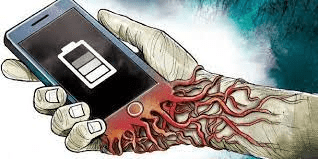Tring….. Tring…Tring….
When was the last time you looked at your phone? Isn’t it ten minutes, five minutes back or even less than that?
Our phones have become an inseparable and an inextricable part of our daily lives for many of us. This phenomenon is without a doubt ubiquitous. According to WHO, 94 percent of participants in a recent survey felt upset when they didn’t have their phone with them, 80 percent felt envious when someone else handled their phone, and 70% anticipated to feel unhappy, scared, and powerless if their phone was lost or stolen. In another survey, half of the participants said they would rather have a broken bone than a damaged phone.

While these figures may not surprise you now, they would have surprised someone four years ago. It wasn’t until 2018 that the majority of Indians owned a smartphone. To put it another way, a single technological item has gone from outdated to an object for which people are prepared to sacrifice food, sleep & family in just four years.
Slow and steady wins the race….here the phone won!!!
This significant uptick in phone usage did not occur overnight. It happened gradually, beginning with a little chemical called dopamine in our brains. Here’s how it went down: You probably did certain things that made you happy when you first acquired your smartphone. Consider reuniting with an old buddy, reading a thoughtful text message from a pal, or receiving a notice. Dopamine was released as a result of all of these processes.
Dopamine? What’s this now?
It’s a dopamine-producing neurotransmitter. When we do something that meets a survival need, such as eating or extremely happy, our brains are designed to release dopamine. Numerous studies have shown that talking on the phone causes our brains to release dopamine, which makes us feel energised, motivated, and happy. Dopamine plays a role in how we feel pleasure. It’s a big part of our unique human ability to think and plan.

However, you undoubtedly performed a few ordinary activities in those first few months of phone use that didn’t make you feel warm and enthusiastic, like aimlessly scrolling through curiously pleasing videos on Instagram or gazing at images of strangers.
However, your brain began to discover a pattern each time you performed anything that caused dopamine to be released. Your brain began to correlate ‘cell phone’ with ‘dopamine’ after a while. And, since your brain wants quick bursts of dopamine, it began to desire your phone.
And then, all of a sudden, a habit arises…………
The pattern becomes imprinted in your brain pathways when you repeat a certain activity that results in a specific reward. Your brain will eventually grow to seek that reward on a regular basis.
That is the fundamental issue with dopamine. It quickly breaks down in your brain, leaving you wanting more and more as soon as possible. As a consequence, after the dopamine impact wears off, your brain will do all it can to recapture that sensation as soon as possible. What’s a quick and easy way to receive a boost of dopamine? You’re about to pick up your phone. That is exactly what your brain instructs your body to do.
The issue is that every Facebook post, text message, YouTube video, tik tok, or Instagram snap will not offer your brain with the knowledge it requires. But we’re designed to work hard for these dopamine highs, and we’ll keep filtering through the mediocrity along the way.We may even add to the reward system ourselves on occasion.
Have you ever found yourself sharing anything on social media simply to make yourself feel better? Or just sending a number of SMS to pals to keep in touch? You’re not alone, so don’t worry. It occurs to the best of us, and it’s due to our working neurological systems.
Why only phones? Why is this happening only on phones and not on other devices? What is it about phones that causes such a dopamine rush?
Take, for example, tablets. They’re similar to phones in that they’re sleek, computerised, and relatively portable. On the other hand, the difference between a phone and a tablet is that we prefer to use tablets for more personal, passive activities like watching movies and reading books. These activities, produce a wholly different brain response.
We, on the other hand, prefer to utilise our phones for a different purpose. They act as a connection point to our social world. We spend the majority of our time texting, looking through social media, and messaging pals on our phones.
So, how does this relate to dopamine? It turns out that all alerts we receive on our phones — from social media, messaging applications, and other sources – cause our brains to release dopamine. In reality, the most addictive smartphone features all have one thing in common: they appeal to people’s urge to connect with others.
Aristotle the legendary Greek philosopher said, “Man is by nature a social animal; an individual who is unsocial naturally and not accidentally is either beneath our notice or more than human. Society is something that precedes the individual.” Man cannot live alone. The need to seek and maintain interpersonal relationships is a basic need of all human beings.
Our need to be sociable is encoded into our brains, much as the release of dopamine. Humans have an innate need to form and sustain strong bonds. It’s as important to our mental health as hunger and thirst are to our physical well-being.
Why? It has its origins in evolution. As humans progressed, they became increasingly reliant on one another to thrive in difficult environments. Those with greater bonds with other humans had a better chance of survival since they have other people to rely on for assistance.
The impulse to keep an eye on other people, in particular, has a long evolutionary history. Humans required constant input from others as they evolved to determine culturally appropriate behaviour. This was their means of achieving significance, long-term objectives, and a sense of self. It’s no surprise that social media – particularly photo sharing – has become so popular.
Overall, it appears that smartphones give us with a platform to fulfil our intrinsic desire for human connection, which, according to Dr. Veissière, is a “basic characteristic of human development that precedes cell phones by hundreds of thousands of years.”
Why can’t we stop picking up the phones????
They satisfy one of our most fundamental needs: human connection, in a quick and easy way.
This appeals to humans in particular since our brains are built to look for shortcuts in order to spare cognitive resources for other activities. Digital businesses simply serves to amplify this impact. Several tech businesses recruit psychologists, neuroscientists, and social scientists to assist them in developing addicting products such as different apps & games that keep dopamine levels high. Dopamine Labs, for example, employs neuroscience to assist tech businesses in making their products more ‘sticky.’
Knowing the psychology behind why we do things can be the first step to stopping our harmful habits….
Is it true that using a phone is harmful?
After all, if our use of smartphones is based on evolutionary needs, they must be beneficial to us in some manner.
According to another poll, cell phones allow us to maintain contact with pals even after changing from high school to college or relocating to a different place. As a result, we’ll be able to tap into a larger network of individuals to confide in, travel with, and learn from.
But it’s also worth noting that in face-to-face situations, our phones may disrupt some of our most crucial connections. Furthermore, studies have shown that even having a phone on the dinner table or present during a meaningful discussion interferes with your sense of connection to the other person. And it’s generally those deep, face-to-face discussions that draw us closer together. It is also true that if either participant placed a mobile device on the table or had it in their hand throughout any talk, the quality of the interaction was assessed as less gratifying.

Participants who pulled their phone out in the middle of a conversation showed less empathy for the other.
Is this a burning issue then???
No, it’s not, but we are on the danger side of that. To begin, let’s establish that cell phone usage does not elicit the same brain reaction as chronic addiction. Phone usage is often not accompanied with high withdrawal symptoms; rather, it is a habit that can be broken with a reset and cleanse.
That is, we may use our phones to remain in touch with our friends while also maintaining a good connection with them.
Start tracking how many times you pick up your phone each day with an app like Moment. It’s possible it’ll catch you off guard. The benefits of reducing that amount by simply 10 or 20 per day may astound you as well or in your mobile Set up Digital Wellbeing by following the below steps-
- Open your phone’s Settings app.
- Tap Digital Wellbeing & parental controls.
- Under “Your Digital Wellbeing tools,” tap Show your data.
Wait for blog-2 on de-addiction of mobile phones…..
For more educational content that nurtures curiosity and learning, I encourage you to visit Chrysalis High.
Sailatha Rajesh,
Principal, Chrysalis High,Kadugodi


